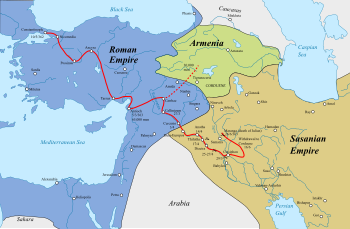Background
After defeating the Persians in battle on the banks of the Tigris and surrounding the capital, Ctesiphon, Julian soon became convinced of his inability to take the city. The apparent impregnability of Ctesiphon, along with his desire to defeat Shapur the Persian king in battle, resolved Julian to abandon the siege. The river fleet which had accompanied the march of the army was abandoned to the flames, and Julian, relying on the fertility of the country for provisions for the troops, ordered the baggage train to be burnt, only 20 days' supplies being preserved. The army then proceeded inland, guided by native captives, who however took care to supply the emperor with misinformation and faulty councils, while Shapur fired the country, harassed the enemies' scouts, and dexterously eluded his main army. Incapable of forcing a battle, Julian fell back on the Tigris, resolved on a retreat north-westwards to the Roman province of Corduene, before his scanty and rotting provisions should run out. [2]
This page is based on this
Wikipedia article Text is available under the
CC BY-SA 4.0 license; additional terms may apply.
Images, videos and audio are available under their respective licenses.
